Today, I would like to talk to you about some Lighthouses from Almería to Huelva.
From the north to the south, the first lighthouse, that you can find, is the named "Mesa Roldán", in Almería, South eastern Spain.
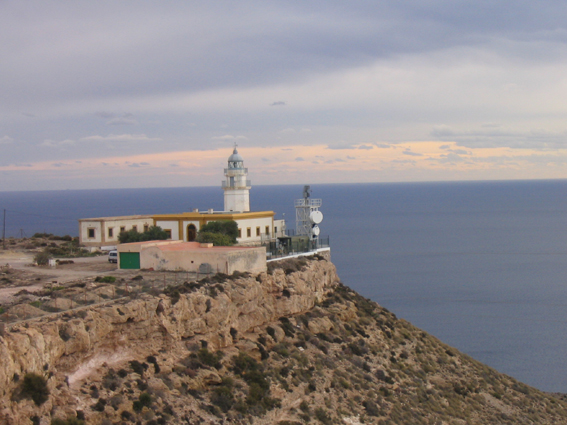
Lighthouse of "Mesa Roldán", Almería
In 1857, was rectified the lighting plan, which did not provide any light, between Cabo de Gata and Cabo Tiñoso, projecting an intermediate light, to connect them.
In 1863, the lighthouse was inaugurated with a device, of fixed white light varied with 3 flashes.
Until 1882, the lamp uses olive oil. From 1882 a Dotty of Parafina.And in 1991, it was started to use oil.
Its octagonal tower, 10.5 m. high, coupled with the height of the plateau, where it is located, leaves the light source to 220 m. above sea level, which made it the highest lighthouse of the peninsula.
In 1923, it is remodeled, giving the appearance of groups of 4 flashes, with white light, replacing the rotating by 4 vertical lenses alternating with screens on a float mercury, powered by clockwork machine and vapor lamp oil pressure part Chance.
In 1972, the signal is electrified with a filament lamp.
In 1986, it automates changing the flashlight, optics and lighting equipment.
From the lighthouse you have seen the history of Carboneras, shipwrecks in the Punta de los Muertos, the maneuvers of the US Marines between 1975 and 1977, the construction of all ports of Carboneras.
Going down to the south, you can find the Lighthouse of La Polacra, in Almería too.
La Polacra belongs to the village "Níjar".
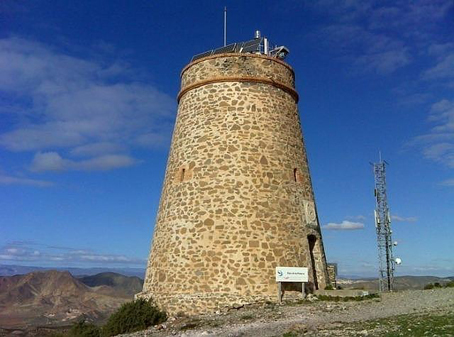
Lighthouse of La Polacra
The story Lighthouse Polacra was born in 1767, when a watchtower on the hill of the wolves was built, with a height of 270 metres for coastal surveillance. In 1849 he was in ruins, and became the property of the Carabinieri first and after the Civil Guard.
In 1987 it was integrated in the Natural Park Cabo de Gata-Nijar, and was rehabilitated by the Ministry of Works Post to lodge at the top of the tower, 14 metres high, a beacon that would cover the space between the lighthouse of Cape de Gata Mesa Roldán.
The access road is cut about 2 kilometres from the lighthouse, and you can only access it on foot, on a road with steep, but the views from the Cerro de los Lobos compensate for the half-hour walk.
The next lighthouse, that you can find, to the south, is the Lighthouse of the Cape of Gata.
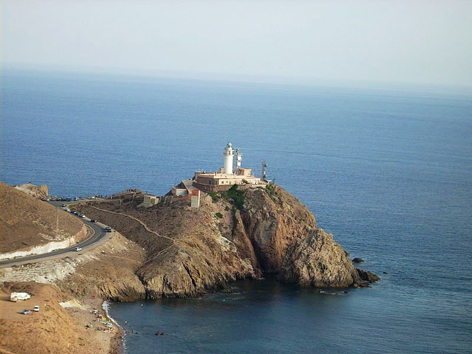
Lighthouse of Cape of Gata
This lighthouse was already known, in times of Greeks and Phoenicians, and used, as a reference point for sailors.
This lighthouse was built in 1863.
It was built on the ruins of the castle of San Francisco de Paula, which was part of the existing maritime defense battery on the Almeria coast and was destroyed during the War of Independence. Built on a cliff of 50 metres and a tower height of 18 meters, the flashes of light are visible 30 miles away, about 45 kilometres, complemented by an audible siren that the days of thick fog activates warning to boats of his presence. The lighthouse was built as a warning to mariners of the presence of dangerous Laja del Cabo, this reef is a nautical mile into the sea off the lighthouse is the cause of many shipwrecks throughout history. The most visited wreck by divers is the ship Czechoslovak Arna, which sank in 1928 when hitting the Laja Cape, and had once transported iron ore and today is shelter for fish and divers entertainment.
This emblematic place receives thousands of visitors every year, I recommend approaching the sunset as the best time, because you can see one of the most beautiful sunsets sun. The lighthouse is near the huge beach of Salinas and has other small coves around, so it is a good choice complete the visit with a bath on its shores.

The beach "Salinas", near of Cape of Gata, Almería

Sunset in beach "San Miguel", Cape of Gata, Almería
To reach the lighthouse, you must take the Al-3115 road, this road from the neighborhood of Cabo de Gata runs along the long straight that runs between the beach and Las Salinas, without abandoning this road, past the neighborhood of La Fabriquilla, the road up to the hill, this final stretch of the road is narrow and winding, narrow pieces in which there can only pass a car but are no more than two or three kilometres. In summer can be formed some jams on this stretch of road due to the influx of visitors, if you decide to spend caravan car this stretch of road jam can be considerable until all vehicles are organized to let the caravan.
A few metres before reaching the lighthouse, on the right, is Corralete beach, is accessed by a path of about 100 metres and a vertical drop. The beach is nice for swimming and offers a splendid view of the raised lighthouse, on the "Punta del cuchillo" (Tip of the knife). From this point there is a path to visit Cala Raja and rthe "Arrecife del dedo" (Reef finger).

Beach "El Corralete" and the Lughthouse
The next lighthouse, to the south, is the Lighthouse of the dyke of Poniente (West).

Lighthouse of tha dyke of Poniente
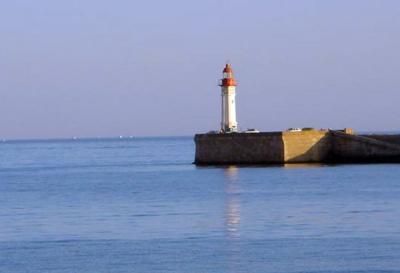
Another view of the Dyke of Poniente, Almería


The torch of this lighthouse

A view of the port and a part of Almería, from the torch of the lighthouse
This lighthouse is not very high; but it's flirtatious. Its tower has an octagonal floor is white and the top is red.
Both at the bottom of the tower as under the balcony of it is decorated with elaborate tiles.
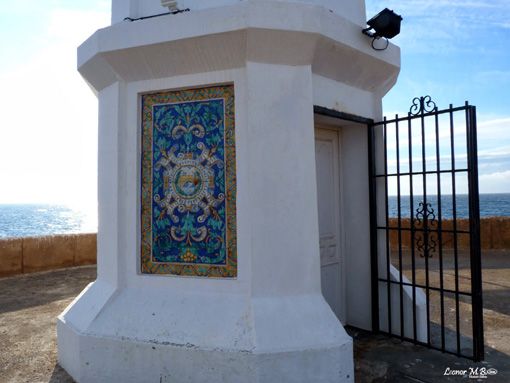
The bottom of the tower
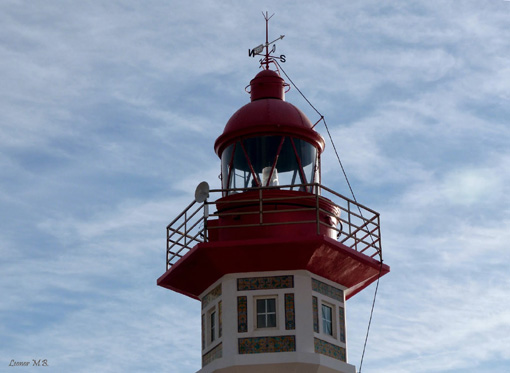
The top of the tower
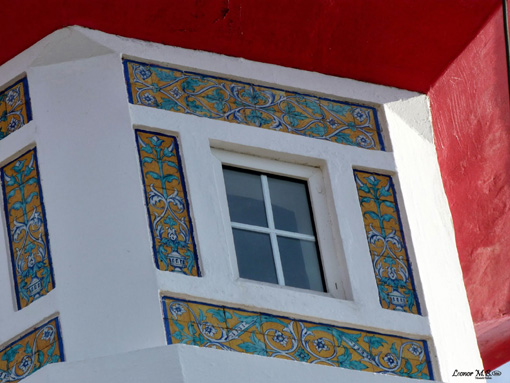
The tiles around a window, in the top of the tower
Following to the south, you can find the Lighthouse of Roquetas de Mar (Almería).
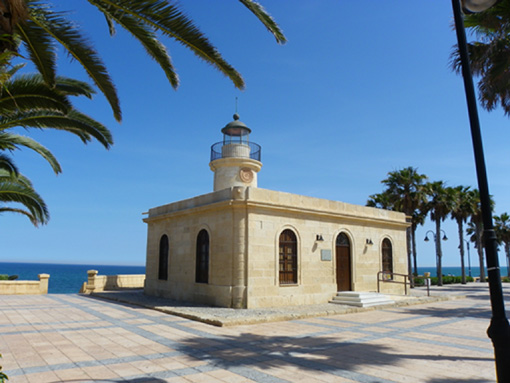
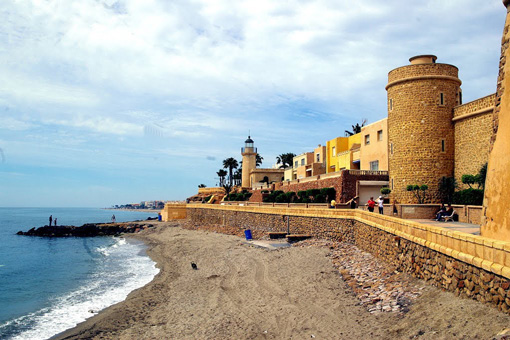
The Castle of Santa Ana and Lighthouse of Roquetas
The Lighthouse was serving, for a long period of time, but later was the subject of a restoration project, that included the grant from the European Union, which allowed it to recover this building as presented since its inception. Currently, the lighthouse of Roquetas de Mar has cultural aim, having become an exhibition hall and samples. So, it has two rooms, each of which displays paintings, sculptures, photographs .. It is located outside the Castle of Santa Ana.
The next lighthouse to the south is the Lighthouse of Point of Baños.
In the maritime Signals Plan of 1985-89, it was considered to place a lighthouse, to illuminate the shadow zone, existing among the lighthouses of Adra and Sabinal. Once recognized the ground, it was decided to place the new lighthouse, in Punta de los Baños, near the castle of Guardias Viejas.
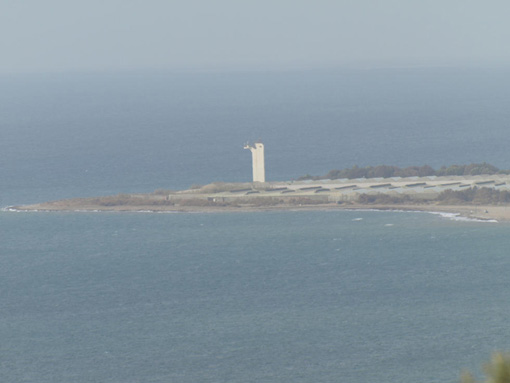
Punta de los Baños and lighthouse, El Ejido, Almería

The Lighthouse of Point of Los Baños
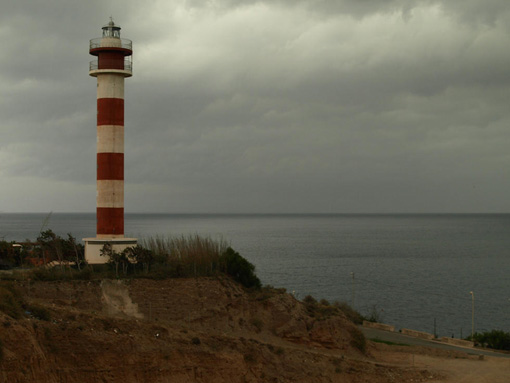
Lighthouse of Adra, Almería

Lighthouse of Sabinal, Almería
In its justification, it was said that this lighthouse (Los Baños) would reduce the risks of Llanos de Almeria or Campo de Dalías, nowadays, covered, totally, by greenhouses, whose lack of relief, in contrast to the elevations of the foothills of Sierra Nevada, which run parallel to the coast, confuse the marine makeing it believe that is farther, from land, than it really is. Also, this lighthouse serve to signal the dangerous low, called "Culo de perro" (Dog´s bum) , which has wrecked many ships.
Now, we are going to change the province to visit; concretely, we are going to the province of Granada. And here you can find a lighthouse named Lighthouse of the Sacratif Cape.
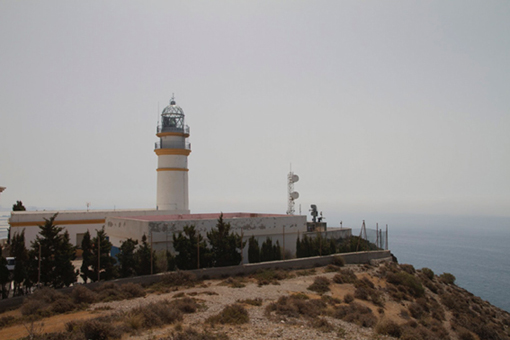
Lighthouse of the Sacratif Cape
The Lighthouse of the Sacratif Cape is situated in Torrenueva, belonged to the village Motril, Granada, south eastern Spain.
It was built in 1863 by engineer Germán Constantino. It is a stone tower with lantern and gallery, which rises on the foundations of a previous tower lookout.
Following to the south, you can find the Lighthouse of Torrox, among El Peñoncillo and Los Llanos.

Lighthouse of Torrox, Málaga
This lighthouse was finished building, in 1864. Its operation is automatic, electric. It has a height of 39 metres, above the sea.
It was built using one of the towers of the Castillo Bajo (Small Castle), destroyed by Napoleon's troops, in the early nineteenth century. In its enclosure, remains of the Roman villa, with wonderful mosaics, are preserved.
Currently, it is being conditioned, to house the Marine Museum of Torrox, inside.
Very close to the lighthouse there are settlements from Roman times. The remains documented so far show the existence of a villa by the sea, dedicated to the exploitation of the same, with a salted fish associated with it, then reused as a necropolis. On the other hand, also they located some bathhouses and a potter complex intended for the production of amphorae that would provide containers for packaging and marketing of salted fish and sauces made from fish produced in the factory.
To the south of Torrox, you can find the Lighthouse "La Farola" (The Lamppost), in the city of Málaga, concretely in the Promenade of The Lamppost.
.jpg)
To the left side, the Promenade of The Lamppost
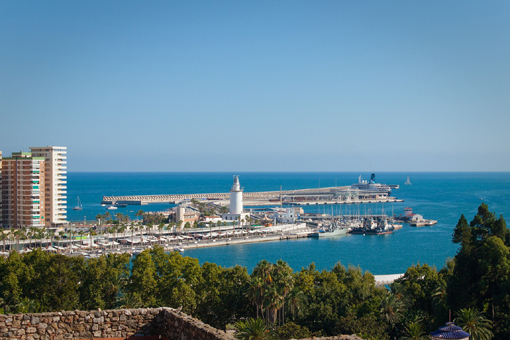
Another view, more near, of the Promenade of the Lamppost

The new area, around the Lighthouse

The Lighthouse "The Lamppost"
The earthquake, occurred in the city, in 1884, left inoperative lighthouse mechanisms; so, ierret participated in the calculations and the house Joules Pintch of Germany in the mechanized, leaving the characteristic of 31 flashes, preserved today. In 1913, the mechanisms of optical were reformed again. In these works the engineer Mauro Serret.
The earthquake occurred in the city in 1884 left inoperative lighthouse mechanisms; so, in 1913, the mechanisms of optical were reformed again. In these works the engineer Mauro Serret participated in the calculations and the house Joules Pintch of Germany in the mechanized, leaving the characteristic of 31 flashes, preserved today.
In 1909, the base was reformed, by adding a floor, that gives the original facade. In May 1916, a float base, bathed in mercury, made in Madrid, by the Spanish Society of Metallic Constructions, was installed.
During the Civil War, August 28, 1936, the lighthouse of Malaga turned out, on the orders of the Navy, still under the command of the Republic as its silhouette served as reference to the naval artillery and aviation rebel army. The Central Committee of the Republican Fleet ordered that earth-colored paint, with dark and light patches to camouflage. Nevertheless, it suffered serious damage during the war, because of which had to be rebuilt, in 1939.
In the late twentieth century, due to the redevelopment of the port area, has been located in the middle of the port .. Under The lighthouse, a parking will be built, while the lighthouse is called to be equipped, to accommodate the future Seaport Museum of Málaga.
Sixty kilometres from Málaga, to the south, you can find the Lighthouse of Marbella.
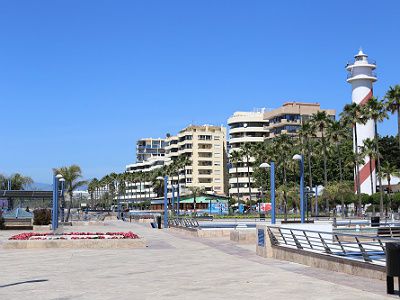
The promenade of Marbella and its Lighthouse, Málaga, Southern Andalusia
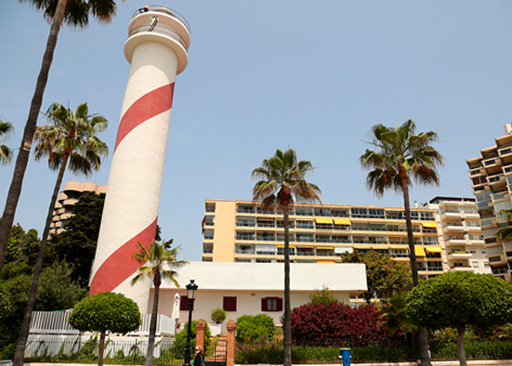
The Lighthouse of Marbella
This Lighthouse is situated in the centre of Marbella.It started to work, in 1864.
It is an electric and automatic lighthouse.
This lighthouse is baside the Marina of Marbella.
The previous lighthouse, under the project by Antonio Molina, was located on a truncated cone tower, with masonry base, 11 meters high, and cast a light, that was fed with olive oil, 12 miles away. It was built in order to illuminate the anchorage of Marbella, where started iron ore, to the port of Malaga. It had a detached building, twin to the Lighthouse of Torre del Mar. It was modified its fuel, in 1882, and by paraffin and by oil later, and was it electrified, in 1944. The current lighthouse was built, in 1974, and it changed its location, cause the urban explosion of the environment and it is installed on a cylindrical concrete tower, 29 metres high, with a range of 22 miles. The lighting is directed by a computerized remote control. It is complemented by a beacon, located near Cabopino, in a place called "Punta Ladrones" (Point Thieves).
Going down to the south, you can find the Lighthouse of "Punta Carnero" (Point Ram), in Algeciras.
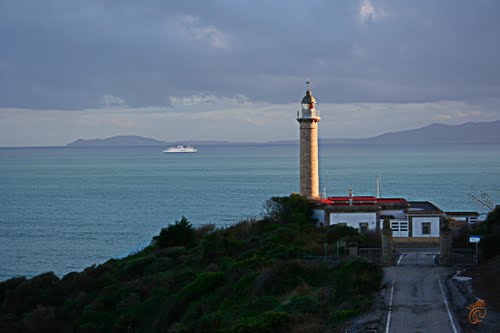
The lighthouse of Punta Carnero and Ceuta (Africa), at the back

The Strait of Gibraltar and a small beach, on the spanish coast (among Algeciras and Tarifa). Picture made by a brother of mine.

On the left side and down of the picture: the Lighthouse of Punta Carnero. Up of it: the Cape and the Lighthouse of Punta Europa (Europe Point), in Gibraltar. Picture made by my brother too.
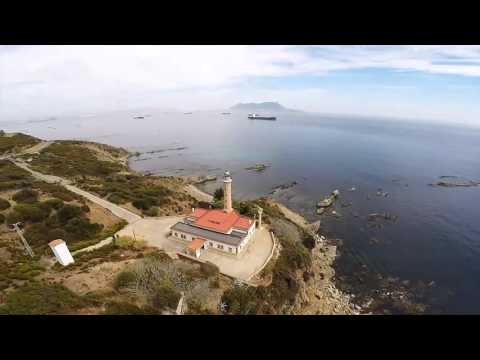
Lighthouse of Punta Carnero with Gibraltar, at the back.

The Lighthouse of Punta Carnero, Algeciras, Cádiz
Projected by Jaime Font, in 1864, it was inaugurated in 1874. It is a cylindrical tower of ashlar of sandstone, of yellow colour. The trunk is a small-scale replica of the Lighthouse of Chipiona (Cadiz). The focal plane is located at 41 m above mean sea level.
Twenty kilometres from Algeciras to the south western Spain, you can find the Lighthouse of Tarifa.
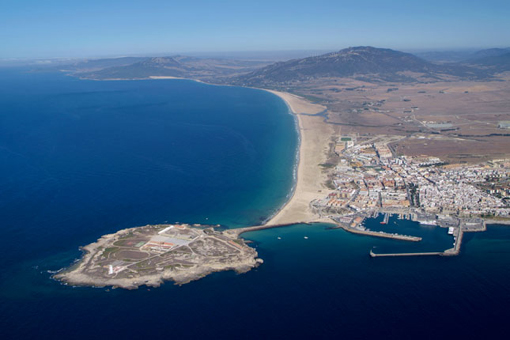
On the right side: Tarifa and, on the left side: the Island "Las Palomas", with the lighthouse
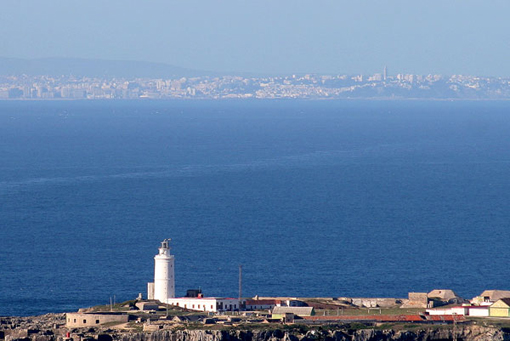
The Lighthouse and Tanger (Africa), at the back
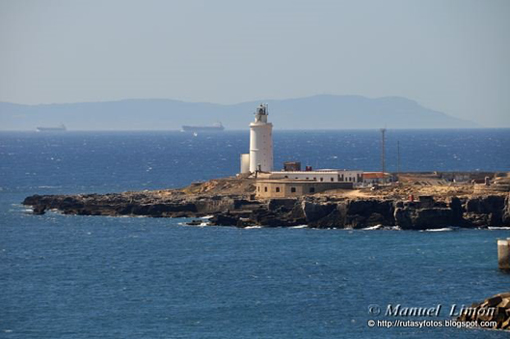
The Lighthouse of Tarifa with Africa at the back
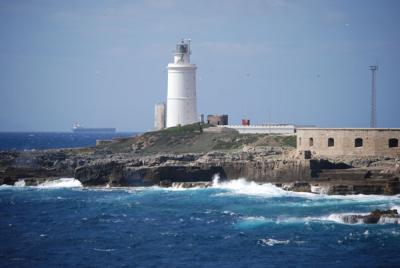
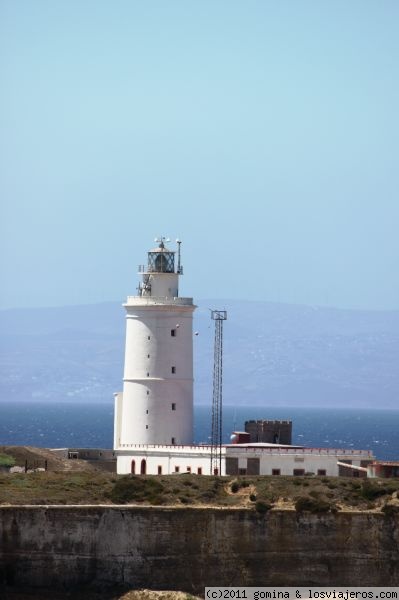
The Lighthouse, close up
This Lighthouse was built in 1826.It has a similar design to the lighthouse of Cadiz.
It is a conical tower, of whitewashed masonry, measuring 43.8 metres high above sea level.
This lighthouse is inside a Spanish Naval Base.
In 1854, J. Martin Villa reform the tower, increasing the height of the second body and suffering reforms and various adaptations in 1887 and 1915. In 1967 it was electrified and in 1976 replaced the lantern light reaching its 27 miles. In 1996/97 it automates and monitors.
The next lighthouse is the Lighthouse of Camariñal; but I am going to talk to you about the next one, to the west: The Lighthouse of Trafalgar, near Barbate, Cádiz.
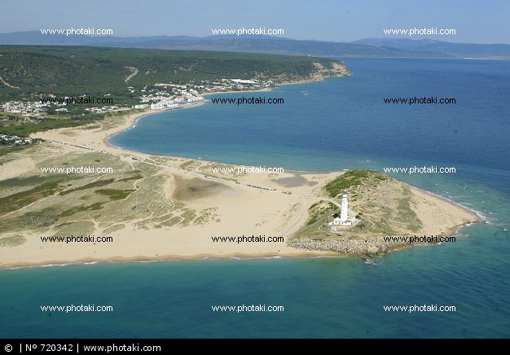
The Lighthouse of Trafalgar
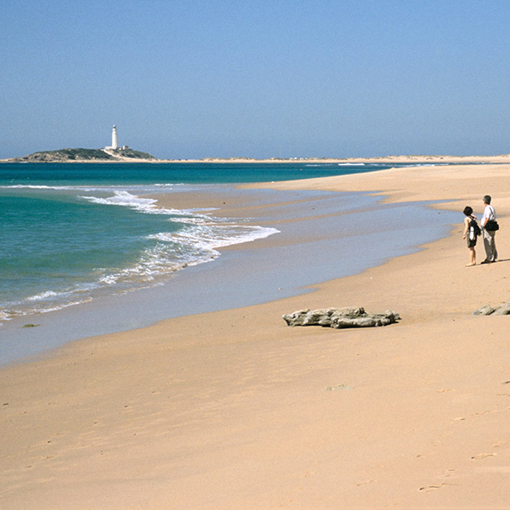
A beach of Barbate and the lighthouse of Trafalgar, at the back on the left side
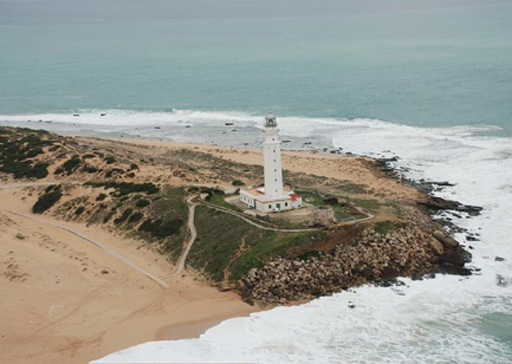
The lighthouse close up

Another angle of the lighthouse of Trafalgar
This lighthouse is on the Trafalgar Cape.
The lighthouse is formed by a white conical tower, 34 meters high.
This lighthouse was built in 1860.
In 1929 the tower was renovated in its factory, siding, while the optical apparatus is renewed and housing of lighthouse keepers improved.
One company will build a luxury hotel, inside the lighthouse.
The next lighthouse, that I should like to show you is the named "Faro de la Punta del perro" ("Lighthouse of the Point of the dog"), in Chipiona, Cádiz.
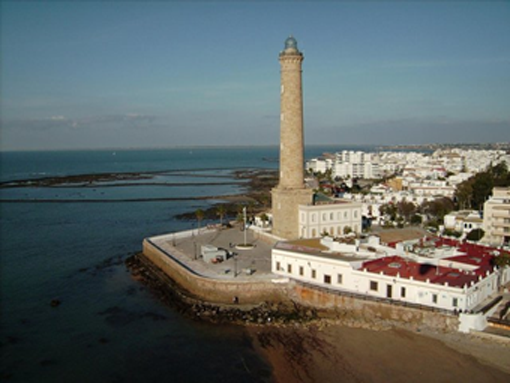
The Lighthouse "Point of the Dog" and the village, Chipiona, Cadiz, Costa de la Luz, South western Spain
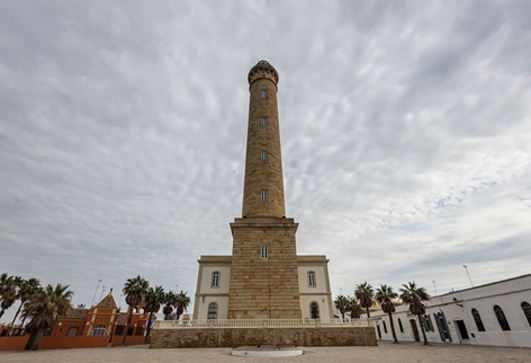
The Lighthouse "Point of the dog"
This lighthouse is the highest lighthouse in Spain, the third in Europe and fifth in the world, measuring 62 metres above the ground.
The first project was devised by Eduardo Saavedra, in 1857.
The final project (the current one) was devised by the engineer Jaime Font, in 1862.
This lighthouse was lit for the first time in 1867 and was off only twice: in 1898 and in 1936.
It is built by a slightly conical tower, recalling the Roman commemorative columns. The elements used in its construction are sandstone ashlar and oyster stone.
It marks to ships the entrance to the estuary of the Guadalquivir River, the only navigable river in Spain. It is also exploited, as a beacon for planes, because it is one of the 20 air-sea lighthouses in Spain.
Since 1998, tourist visits are organized to see the inside of the lighthouse and in 1999 the existing lamp was changed by a halogen with a range of 30 nautical miles.
Going to the west, you can arrive to the andalusian village, Cartaya, in Huelva (the last andalusian province, to the west, before Portugal). And, there, you can find the Lighthouse of El Rompido.
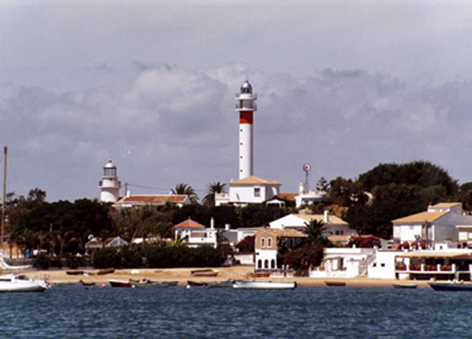
The lighthouse El Rompido, Huelva, Costa de La Luz, South western Spain
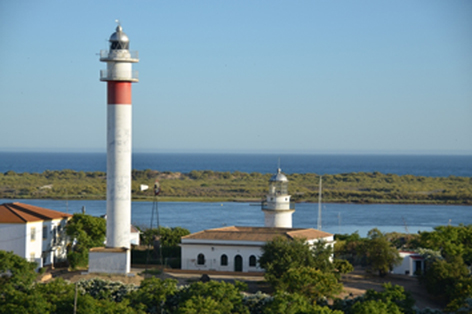
The lighthouse with the "Piedras" (Stones) river and the "Flecha" (Arrow) beach, at the back
The old lighthouse was built in 1861 and the new one, in 1975.
You can visit the old lighthouse, If you ask for an appointment.
The old lighthouse, built on project by Angel Mayo and came to mark out the mouth of the Piedras River, to the height, where on the Arrow (beach), the Punta del Gato was. Frustoconical shape and decagonal lantern, that resembles the Lighthouse Mesa Roldan (Almeria), it has a height of 13 metres and a range of lighting of 16 miles. From 1930 and the greater scope, that is acquiring Mazagon Lighthouse is losing importance, so its lighting is replaced by a permanent one acetylene. 1976 stops working when it begins to operate the new lighthouse.
The construction of a new lighthouse is because given the situation a lighthouse of greater height (31 meters) to allow complete navigation arch from Ayamonte to Huelva was needed. Cylindrically shaped and reinforced concrete, is like the lighthouse that is located at the entrance of the port of Huelva. Its range is 24 miles.
Well, I hope that you have liked this walk, through the lighthouses of Andalusia, and that you can do it ever.
Until my next post, kind regards,
Luis.
Sponsored by Costaluz Lawyers.
Please click below:
